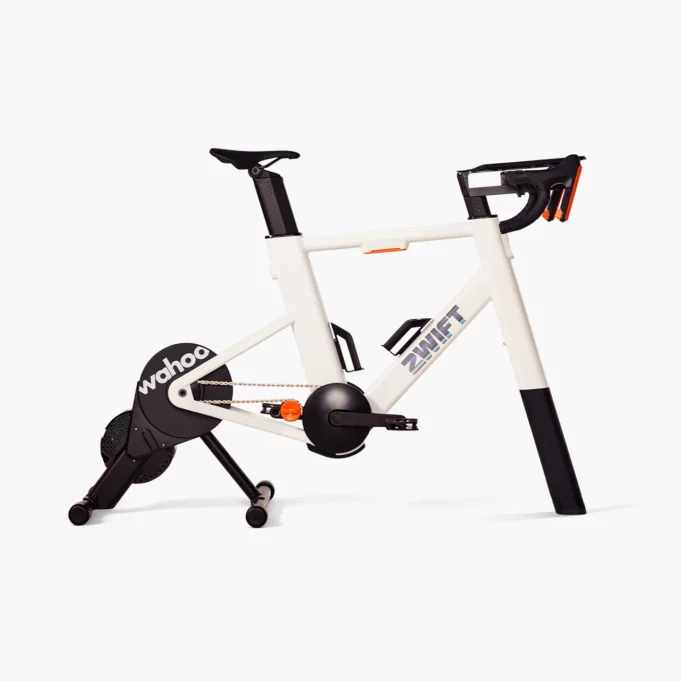Another at-home fitness bike is about to hit the market.
Zwift has finally taken the wraps of its in-house designed and branded bike. Due to start shipping later this month, the California-based company is calling it Zwift Ride and it will sell for $1,299 USD and include everything you need to get up and running. Save for one additional expense — a monthly (or annual) subscription to the Zwift app which currently costs $19.99 per month ($249 annually).
Comparatively, the Peloton Bike now sells for $1,445. And the Peloton membership is $44 per month.
As for the bike itself, it’s actually comprised of two components:
- A metal frame with pedals, handlebars and water bottle holders
- A rear smart trainer (Wahoo Kickr Core) that simulates the resistance and cadence of a real bike
Unlike, say, something like a Peloton bike, buyers will need to bring their own displays and phones to complete the experience. An optional tablet holder is available for $49 which attaches to the front, providing a convenient place to mount an Apple iPad or Android tablet to run the Zwift app and display vistas and racing metrics. A middle tray located between the handlebars is a handy place to put your phone, providing a secondary Zwift screen for various controls and options.
Other key features being promoted for the Zwift Ride include:
- In-game gradient changes that automatically adjust the bike’s resistance
- Buttons to control shifting, and three customizable virtual shift styles (Sequential, Shimano, SRAM)
- A real chain for the drivetrain
- Flat pedals are included and are compatible with standard road and mountain pedals (so you can swap them with your favorite standard cleat of choice)
- Speed, distance, cadence and power are wirelessly transmitted
- Quiet and compact design
Zwift Ride is finished in white with black accents and a ZWIFT logo emblazoned across the down tube.

Zwift says the frame will accommodate riders in size from 5′ to 6’6″ and a weight maximum of 265 pounds.
Buyers will receive three separate boxes upon delivery: one for the Zwift Ride handlebars (8.2 lbs.), a second for the frame itself (48.5 lbs.), and a third containing the KICKR CORE unit (47 lbs.).
Shipping is $75 and there’s a standard 30-day return policy.
Zwift Ride — Looks pretty great!

I’ve been following the indoor cycling space off-and-on every since we purchased a pandemic Peloton in 2020. No doubt, the Peloton Bike is outstanding. It changed the at-home fitness game for us, and offered an alternative when gyms across the country were shutting down.
However, while spin classes are generally fun and do, indeed, deliver as promised on getting the heart rate going, and, ultimately, improving cardio fitness, I do sometimes look over my shoulder at the intriguing world that is Zwift. The gamification element looks compelling and the idea of group rides, and cycling across virtual countryside’s and cityscapes does seem like a nice change-up to looking at just an instructor for 30-minutes or so.
Researching the smart bike market, however, in the past revealed that these things were pretty expensive.
For instance, the popular Tacx NEO Bike Smart Trainer (now owned by Garmin) sells for $3,199 USD.
UK-based Wattbike sells its Atom smart bike for $2,549.
So the idea of an out-of-the-box easy to setup smart bike that is fully compatible with Zwift for $1,299 should draw interest in those who like the idea of Zwift, but aren’t as serious as a more committed indoor cycling enthusiast. Perhaps, even those who might otherwise cross-shop and buy a Peloton?
Granted, the Zwift Ride lacks a lot of the fancy features found on the more expensive competition. If you want simulated road surfaces, or a frame that tilts and moves, or built-in USB charging, etc., you’ll need to look elsewhere — and expect to pay a lot more.
The real draw for Zwift, the company, is, of course, the recurring subscription fee. Undercutting others with a relatively affordable solution means the probability of drawing more riders into the Zwift ecosystem goes up. And as that goes up, so too does its more predictable revenue stream. We all know the story of monthly subscriptions these days.
Early reviews of the Zwift Ride seem generally positive.
Popular fitness and tech blog DC Rainmaker suggests that the Zwift Ride may well represent the “Future of Indoor Bikes?”, stating in the Wrap-Up:
“Every once in a while there’s a product that’s going to significantly change the direction of an industry. Zwift Ride is one of those… The Zwift Ride is legit very good, and legit very much competes (very strongly) with all the sub-$3,000 smart bikes in the market, and frankly, with some of the $4,000 ones too.”
Cyclist awarded the Zwift Ride “recommended” and “great value” badges while noting at least one key limitation:
“The trainer massively undercuts the smart bike market in price and does so with a high performing, and incredibly fun and practical setup… The Zwift play functions make using Zwift an absolute breeze with this system, but being compatible only with Zwift does limit its broader appeal.”
An interesting side benefit of the modular design of the Zwift Ride worth pointing out: you can un-attach the KICKR CORE unit and use it independently on a road bike. So if you want to train on your summer road bike during the winter you can use that frame instead. And then use the Zwift Ride frame during the rest of the season. There’s some flexibility in that regard not found on most other smart bikes.
Many won’t be happy with the fixed crank arm length of 170mm. That’s the same as Peloton so, for me at least, it’s absolutely fine. I suspect most casual users won’t mind or even know that this adjustment even exists (the bear claw found on most other smart bikes). For serious and more experienced riders this could be a issue and even dealbreaker. It will just depend on the buyer profile. And, again, I believe Zwift is trying to broaden the potential market for this bike, and keep costs down, while also keeping things relatively simple.
WATCH: Zwift Video Review (DC Rainmaker)
Aside from the lack of real gearing controls found on a typical road bike (Zwift Ride instead uses buttons more akin to video game controls), I’d say Zwift nailed it. The bike was worth the wait. For those interested in Zwifting, I think this bike mikes a strong case for most buyers. You’re buying direct so you can expect integration to be solid, and the company is likely to give its in-house bike priority when rolling out new features and updates, so that’s a plus to consider.
True, it’s early. But so far this new Zwift smart bike seems to offer excellent value. Especially consider, it’s $145 cheaper than the Peloton Bike, and the membership is less than half the cost ($20 vs. $44 per month for Peloton).
The Zwift Ride sells for $1,299 USD with shipments starting June 26, 2024.


